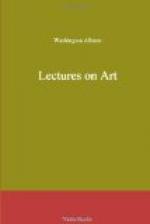Assuming, then, its reality,—or rather leaving it to be evidenced from its known effects,—we proceed to inquire in what consists this originating power.
And, first, as to its most simple form. If it be true, (as we hope to set forth more at large in a future discourse,) that no two minds were ever found to be identical, there must then in every individual mind be something which is not in any other. And, if this unknown something is also found to give its peculiar hue, so to speak, to every impression from outward objects, it seems but a natural inference, that, whatever it be, it must possess a pervading force over the entire mind,—at least, in relation to what is external. But, though this may truly be affirmed of man generally, from its evidence in any one person, we shall be far from the fact, should we therefore affirm, that, otherwise than potentially, the power of outwardly manifesting it is also universal. We know that it is not,—and our daily experience proves that the power of reproducing or giving out the individualized impressions is widely different in different men. With some it is so feeble as apparently never to act; and, so far as our subject is concerned, it may practically be said not to exist; of which we have abundant examples in other mental phenomena, where an imperfect activity often renders the existence of some essential faculty a virtual nullity. When it acts in the higher decrees, so as to make another see or feel as the Individual saw or felt,—this, in relation to Art, is what we mean, in its strictest sense, by Originality. He, therefore, who possesses the power of presenting to another the precise images or emotions as they existed in himself, presents that which can be found nowhere else, and was first found by and within himself; and, however light or trifling, where these are true as to his own mind, their author is so far an originator.
But let us take an example, and suppose two portraits; simple heads, without accessories, that is, with blank backgrounds, such as we often see, where no attempt is made at composition; and both by artists of equal talent, employing the same materials, and conducting their work according to the same technical process. We will also suppose ourselves acquainted with the person represented, with whom to compare them. Who, that has ever made a similar comparison, will expect to find them identical? On the contrary, though in all respects equal, in execution, likeness, &c., we shall still perceive a certain exclusive something that will instantly distinguish the one from the other, and both from the original. And yet they shall both seem to us true. But they will be true to us also in a double sense; namely, as to the living original and as to the individuality of the different painters. Where such is the result, both artists must originate, inasmuch as they both outwardly realize the individual image of their distinctive minds.




